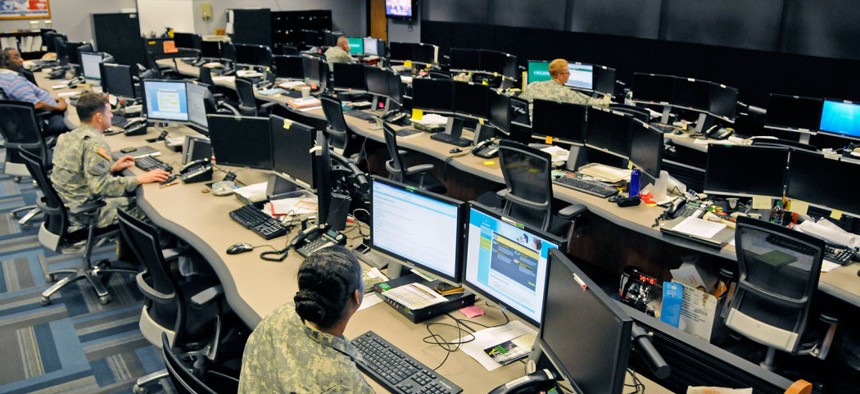Army's Cyber Blitz takes aim at cyber/EW convergence
In a recent two-week exercise, the Army tried to more seamlessly integrate cyber and electromagnetic spectrum operations, which is seen as a necessary response to emerging threats.
The military has already designated cyberspace as the fifth domain of war – along with the four physical domains of air, land, sea and space – and it’s mulling making the electromagnetic spectrum the sixth domain. Frequently, however, the two are converging, as a recent exercise demonstrated.
Personnel from the 25th Infantry Division and the 7th Signal Command Cyber Protection Brigade participated in a “Cyber Blitz” during the last two weeks of April at the Army Materiel Command’s Communications-Electronics Research, Development and Engineering Center, or CERDEC, focusing on testing new operations concepts in realistic training scenarios, the Army said in a release.
Cyber Blitzed forced soldiers to account for interactions in cyber electromagnetic activities in a tactical operations center, which does not typically occur in most other training scenarios.
“We’ve been talking about cyber for what appears to be a long time, but it’s really been for a relatively short time, only 10 years,” said Henry Muller, CERDEC director. “As technology evolves so rapidly and we continue to eat up and crowd the electromagnetic spectrum, to be able to operate in cyber is becoming more and more important to the Army.”
The Cyber Blitz examined physical constructs of the main command post along with the interactions between military operations specialties. Tactical operations centers, which host operations, intelligence and fire support, are physically separate from newer roles associated with communications, network protection, electronic warfare and spectrum analysis, the Army said. Soldiers underwent a series of simulated scenarios to address these concerns.
During a panel discussion in March at an event hosted by AFCEA NOVA, Portia Crowe, director of Cyber ops and CIO for PEO Command Control Communications Tactical, explained that the Army, with the Cyber Blitz, is “making a very deliberate exercise to actually focus” on delivering simple systems to connect and better converge cyber and intelligence. “You’ll see the intel and you’ll see signal, EW, fires all working together off the same data,” in an effort to go from collaboration to convergence in the tactical operations center, she said. “Right now we’ve got secret data, we’ve got [top secret] data. What we’re trying to do is say, everybody’s got access to the right data...everybody can see that picture, that’s where your data convergence comes into play, your analytic tools on top of that and then just having that seamless cell working together to exchange the data and understand where the mission threats are and how to make better decisions.”
“Our Army is and will remain in the near future a commander-centric Army,” said Lt. Col. Brent Clemmer, commander of the 25th Infantry Division, 1st Battalion, 21st Infantry Regiment. “The challenge here is you have folks who are very used to excelling in their cylinder of excellence - whether it’s looking at the spectrum, whether it’s looking at the network. But what they are not used to doing is describing to a commander the risks posed to that network that also provides a risk to operations on the ground.”
EW capabilities are something the Army is looking to build up after years of neglect. “The Army maintained communications electronic warfare battalions during the Cold War, but were disbanded in the 1990s, causing significant deficiencies in electronic warfare capabilities, which were grimly recognized during combat operations in Iraq and Afghanistan,” Maj Michael Senft, Functional Area 24 program manager at the Office Chief of Signal, wrote in the Cyber Defense Review. “With less than 1,000 officers, warrant officers and enlisted personnel, the EW career field has struggled with finding its role as combat deployments have significantly decreased. As a result, when not deployed, EW personnel are often assigned to other duties, resulting in EW is often derided as standing for ‘extra worker’. Exacerbating this problem, the Army will not field a standard electronic warfare capability, with the Multifunctional Electronic Warfare (MFEW) program not slated to reach initial operating capability until 2023.”
“I’m an infantry man; I’ve been doing it for 18 years, but I’m having to learn a little bit of a different language as well to communicate these ideas across the cyber realm that, frankly, I didn’t have to worry about for the past 18 years of my career,” Clemmer said exemplifying the cultural challenges in EW.
Results from the Cyber Blitz will not only help the Army develop doctrines for how a tactical operations center can support a forward brigade, but it will also help make better investments.
“We invest roughly $60 million a year in advancing the Army from an S&T perspective. Now we will have a greater confidence that we are pursuing the right capabilities based on what we see coming out of Cyber Blitz when we are again putting capabilities in the soldiers’ hands – getting their feedback on what gaps they see, what gaps they need filled – to inform for us our S&T investments going forward,” said John Willison, CERDEC Space and Terrestrial Communications Directorate, or S&TCD, director.
The renewed interest in EW is also a response to emerging threats. “Two years ago as we started to look at how the world was changing and how the threat was evolving, what we recognized was regional peers and the near-peer threat had started to understand what our advantages were and started to develop capabilities to counter those advantages,” said Maj. Gen. Stephen Fogarty, U.S. Army Cyber Center of Excellence commanding general. “Our problem was how to optimize our ability to integrate staff functions, support the commander in a very high-intensity fight, in a fight that includes a very contested cyber and electromagnetic component.”
The Army said further analysis of the Cyber Blitz will take place during the next few months and be applied during the Army’s Cyber Quest exercise, which is set for July.




